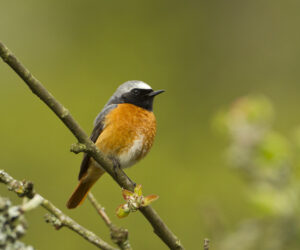The common redstart is identifiable by its slim stature, erect posture and rusty-red quivering tail. Adult males look to be ‘elegantly dressed’ with a black throat, orange-red breast, white forehead with an ash-grey crown and back. The female has a distinctly paler throat, and is grey-brown above and buff-white with tinges of orange below.
Behaviour
The vibrating tail and constant bobbing of the common redstart are characteristic as it perches, but it spends little time at ground-level. They breed in Britain, in upland broadleaf woodland (commonly oak and hazel) areas and hedgerow trees. The male performs various courtship displays to attract a female, including crouching and facing a potential mate with its wings raised and the tail fanned, displaying its bright orange-red colouration. It will also show off potential nest sites to the female by perching on or near possible nest holes. The female generally lays a clutch of 5 to 7 eggs, which she incubates for 12 to 14 days. The chicks remain in the nest for around 12 to 15 days before they fledge.
The common redstart preferentially forages in areas of low, sparse vegetation where prey is more accessible, such as under trees at the edges of woodland and in freshly mown meadows or gardens.
The common redstart’s call is a soft whistled ‘huit’ frequently followed by persistent clicking ‘tick tick tick’.
Size
- Length: 14 cm
- Wingspan: 20-24 cm
- Weight: 11-19 g
- Average lifespan: 5 years
Status
Classified in the UK as Amber under the Birds of Conservation Concern 4: the Red List for Birds (2015); protected by The Wildlife and Countryside Act 1981.
Distribution
The common redstart is mainly found in the north and west of the UK, with greatest concentrations in Wales. In Scotland, it is a summer visitor, most common in the north and west, with passage migrants found along the North Sea coast (e.g., Fair Isle, Isle of May, Shetland and Orkney), mostly in April and mid-September.
Redstarts depart from the UK around mid-August and return to the warmer climates in Africa and Asia for the winter.
When to see
April to late August
Facts
- ‘Phoenicurus’ is, from its original translation, a combination of two ancient Greek terms: “phoinix”, which means “red”, and “-ouros”, meaning “tailed”; so, a very straightforward name i.e., red-tailed, or, as it is known now, redstart.
- Formerly thought to be a member of the thrush family, the common redstart is now commonly considered to belong to the family of old world flycatchers. Two sub-species are recognised, Phoenicurus phoenicurus phoenicurus and Phoenicurus phoenicurus samamiscus. The latter differs slightly in appearance by the presence of a white wing panel, but it is the former which breeds in the British Isles.
- The main difference between the common redstart and the black redstart is that the former have bright red under parts, black facial features and a smooth grey colouring that starts at the crown and ends at the tip of the tail. Black redstarts, in contrast, are much darker in colour, with a rufous-red tail; they are a scarce passage migrant in Scotland.

